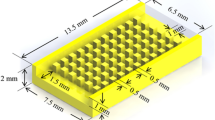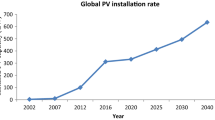Abstract
This study aimed to numerically investigate the parametric effects of fin geometry on the heat transfer characteristics of 72 V electronic control unit (ECU) heatsink for an electric three-wheeler. The temperature distribution, fin efficiency, and thermal resistance of the 72 V ECU heatsink were compared by varying the fin geometry parameters, including fin thickness, number, height, and depth. The maximum cooling performance was observed for the proposed fin arrangement with a fin thickness of 2.1 mm, fin number of 60, fin height of 16 mm, and fin depth of 8 mm, in comparison with the existing heatsink model. The proposed 72 V ECU heatsink model was validated with the experimental results of the existing heatsink model and indicated a good agreement within ±4.97 %. The optimized ECU heatsink enhanced the heat transfer performance, thereby decreasing the temperatures of the heatsink, capacitor, and metal-oxidesemiconductor field-effect transistor for the proposed 72 V ECU heatsink model by 16.88 %, 12.71 % and 18.95 %, respectively, in comparison with the existing heatsink model.
Similar content being viewed by others
References
C. Zapata and P. Noeuwenhuis, Exploring innovation in the automotive industry: New technologies for cleaner cars, Journal of Cleaner Production, 18 (2010) 14–20
A. Coad, P. D. Haan and J. S. Woersdorfer, Consumer support for environmental policies: An application to purchases of green cars, Ecological Economics, 68 (2009) 2078–2086
J. M. Miller, A. Emad, A. V. Rajarathnam and M. Ehsani, Current status and future trends in more electric car power system, IEEE 49th Vehicular Technology Conference, Houston, Texas, USA (1999).
K. C. Otiaba, N. N. Ekere, R. S. Bhatti, S. Mallik, M. O. Alam and E. H. Amalu, Thermal interface materials for automotive electronic control unit: Trends, technology and R&D challenges, Microelectronics Reliability, 51 (2011) 2031–2043
G. Hetsroni, A. Mosyak, Z. Segal and G. Ziskind, Uniform temperature heatsink for cooling of electronic devices, International Journal of Heat and Mass Transfer, 45 (2002) 3275–3286
C. C. Wang, A survey of recent patents of fin and tube heat exchangers from 2001 to 2009, International Journal of Air-Conditioning and Refrigeration, 18 (1) (2010) 1–13.
K. T. Chiang, F. P. Chang and T. C. Tsai, Optimum design parameters of pin-fin heatsink using the grey-fuzzy logic based on the orthogonal arrays, International Communications in Heat and Mass Transfer, 33 (2006) 744–752
R. Ricci and S. Montelpare, An experimental IR thermographic method for the evaluation of the heat transfer coefficient of liquid-cooled short pin fins arranged in line, Experimental Thermal and Fluid Science, 30 (2006) 381–391
C. C. Wang, Recent advantages in fin and tube heat exchanger, International Journal of Air-Conditioning and Refrigeration, 19 (4) (2011) 291–301.
A. A. Khan and K. Y Kim, Evaluation of various channel shapes of a microchannel heatsink, International Journal of Air-Conditioning and Refrigeration, 24 (3) (2016) 1650018.
N. Matsumoto, T. Tomimura and Y. Koito, Heat transfer characteristics of square micro pin fins under natural convection, Journal of Electronics Cooling and Thermal Control, 4 (3) (2014) 282–290.
H. Cho, T. Kim, J. Kim, C. Lee and J. Choi, Simulation results for the effect of fin geometry on the performance of a concentric heat exchanger, International Journal of Airconditioning and Refrigeration, 22 (4) (2014) 1450020.
A. Dvinsky, A. Bar-Cohen and M. Strelets, Thermofluid analysis of staggered and In-line pin fin heatsinks, The Seventh Inter-Society Conference on Thermal Phenomena 2000, Hanover, New Hampshire, USA (2000).
W. A. Khan, J. R. Culham and M. M. Yovanovich, Modeling of cylindrical pin-fin heatsinks for electronic packaging, IEEE Transactions on Components and Packaging Technologies, 31 (2008) 536–545
Y. Takashi, S. Sugiura, H. Wakabayashi, T. Yasuhara, T. Watanabe and S. Koshiji, Engine control ECU development for '05 standard model, www.denso-ten.com/business/technicaljournal/ pdf/26–1.pdf (2006) (accessed on 8th of Oct 2018).
S. Aydogan, M. Saglam and A. Turut, Effect of temperature on the capacitance–frequency and conductance–voltage characteristics of polyaniline/p-Si/Al MIS device at high frequencies, Microelectronics Reliability, 52 (2012) 1362–1366
W. Greason and J. Critchley, Shelf-life evaluation of aluminum electrolytic capacitors, IEEE Transactions on Components, Hybrids, and Manufacturing Technology, 9 (1986) 293–299
J. Jose, A. Ravindran and K. K. Nair, Study of temperature dependency on MOSFET parameter using MATLAB, International Research Journal of Engineering and Technology, 3 (7) (2016) 1530–1533.
C. T. Chen and S. H. Jan, Dynamic simulation, optimal design and control of pin-fin heatsink processes, Journal of the Taiwan Institute of Chemical Engineers, 43 (2012) 77–88
Y. M. Bang, M. S. Patil, J. H. Seo and M. Y. Lee, Experimental and numerical study on the thermal performances of battery cell and ECU for an E-bike. AETA: Recent Advances in Electrical Engineering and Related Sciences, Springer International Publishing (2016) 195–204.
M. S. Patil, Y. M. Bang, J. H. Seo, D. W. Kim and M. Y. Lee, Heat transfer characteristics of electronic control unit heatsink for 72 V neighborhood electric vehicle, 1st Asian Conference on Thermal Sciences, Jeju, South Korea (2017).
H. S. Lee, C. W. Cho and J. H. Seo, Cooling performance characteristics of the stack thermal management system for fuel cell electric vehicle under actual driving conditions, Energies, 9 (2016) 320–334
CATIA, https://www.3ds.com/products-services/catia.
STH15810–2.DATASHEET, www.verical.com/datasheet/ stmicroelectronics-fet-mosfet-sth15810–2-1812787 (Accessed 8th of July 2018).
Satan@TS13DCD263Aluminiumcapacitor, www.suntan. com.hk/pdf/Aluminum-Electrolytic-Capacitors/TS13DG-CD263 (Accessed 8th of July 2017).
ANSYS® Academic Research, Release 16.2; ANSYS: Pittsburgh, PA, USA (2015).
J. P. Holman, Heat Transfer, 10th edition, The McGraw-Hill Companies, Avenue of the Americas, New York, USA (2010) 48–120.
M. Ahmadi, M. F. Pakdaman and M. Bahrami, Pushing the limits of vertical naturally-cooled heatsinks; Calculations and design methodology, International Journal of Heat and Mass Transfer, 87 (2015) 11–23
F. P. Incropera, D. P. Dewitt, T. L. Bergman and A. S. Lavine, Principles of Heat and Mass Transfer, 7th edition, John Wiley and Sons, Inc., 111 Rivers street, Hoboken, New jersey, USA (2013) 164–167.
P. Evans, Properties of air at atmospheric pressure, The engineeringmindeset.com, http://theengineeringmindset.com/ properties-of-air-at-atmospheric-pressure (2015) (Accessed 8th of July 2018).
M. S. Patil, Y. M. Bang, J. H. Seo, D. W. Kim, B. D. Cho and M. Y. Lee, Experimental investigation of heat transfer characteristics of battery management system and electronic control unit of neighborhood electric vehicle, Recent Advances in Electrical Engineering and Related Sciences, 415 (2016) 205–211
E. G. Miller, Optimum fin spacing for heat transfer per unit length of heat exchange section, Masters Theses, University of Missouri, USA (1967).
A. T. Morrison, Optimization of heat sink fin geometries for heat sinks in natural convection, Intersociety Conference on Thermal Phenomena in Electronic Systems, Austin, Texas, USA (1992).
M. Fathi, A. Assat and M. Abderrazak, Optimization of the electronic Driver and thermal management of LEDs lighting powered by solar PV, Energy Procedia, 18 (2012) 291–299
S. W. Churchill and H. S. Humbert, Correlating equations for laminar and turbulent free convection from a vertical plate, International Journal of Heat and Mass Transfer, 18 (11) (1975) 1323–1329.
S. V. Raunt and B. S. Kothavale, Study on thermal performance of micro fin heat sink under natural convection–A Review, International Journal of Current Engineering and Technology (2017) 257–261.
Author information
Authors and Affiliations
Corresponding author
Additional information
Recommended by Associate Editor Chang Yong Park
Gihan Ekanayake is currently a master candidate at the Department of Mechanical Engineering, Dong-A University, Republic of Korea. He received his bachelor’s degree from the University of Peradeniya, Sri Lanka, in 2013. His research interests include electric vehicle power train and thermal management of lithium ion battery.
Mahesh Suresh Patil is currently a Ph.D. candidate at the Department of Mechanical Engineering, Dong-A University, Republic of Korea. He received his master’s degree in Thermal Sciences from the National Institute of Technology Calicut, India, in 2015. He received his bachelor’s degree from the Sardar Vallabhbhai National Institute of Technology, Surat, India, in 2011. His research interests include electric cars and thermal management systems.
Jae-Hyeong Seo is currently a Ph.D. candidate at the Department of Mechanical Engineering, Dong-A University, Republic of Korea. He received his master’s degree from the same university in 2011. His research interests include thermal management system for an electric vehicle and nanofluid heat transfer.
Moo-Yeon Lee is currently an Associate Professor at the Department of Mechanical Engineering, Dong-A University, Republic of Korea. His main research interests include heat and mass transfer, new and renewable energy conversion system, and thermal management system for electric cars.
Rights and permissions
About this article
Cite this article
Ekanayake, G., Patil, M.S., Seo, JH. et al. Numerical study of fin geometry on the heat transfer characteristics of 72 V ECU heatsink for an electric three-wheeler. J Mech Sci Technol 33, 1451–1462 (2019). https://doi.org/10.1007/s12206-019-0247-8
Received:
Revised:
Accepted:
Published:
Issue Date:
DOI: https://doi.org/10.1007/s12206-019-0247-8




